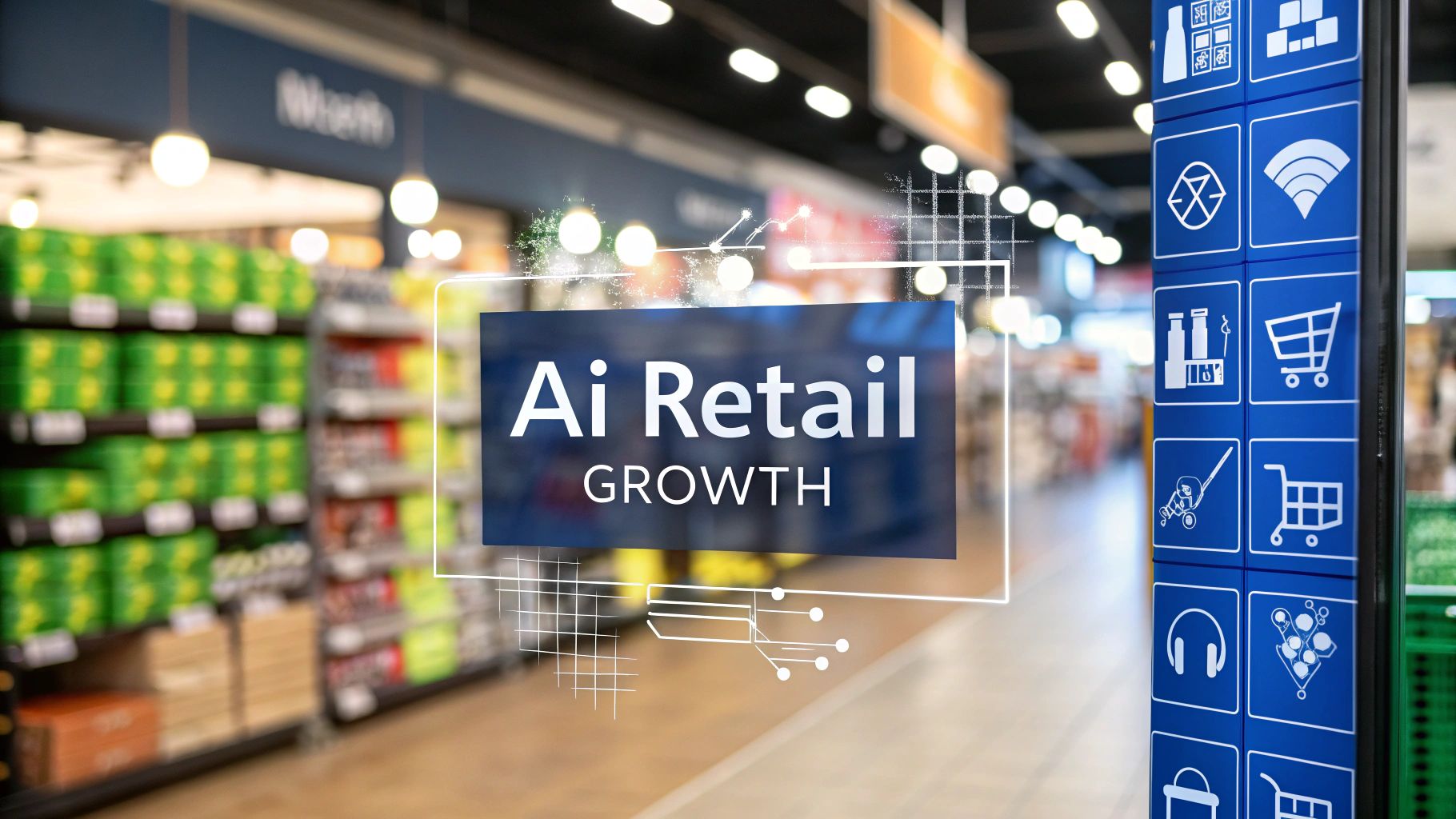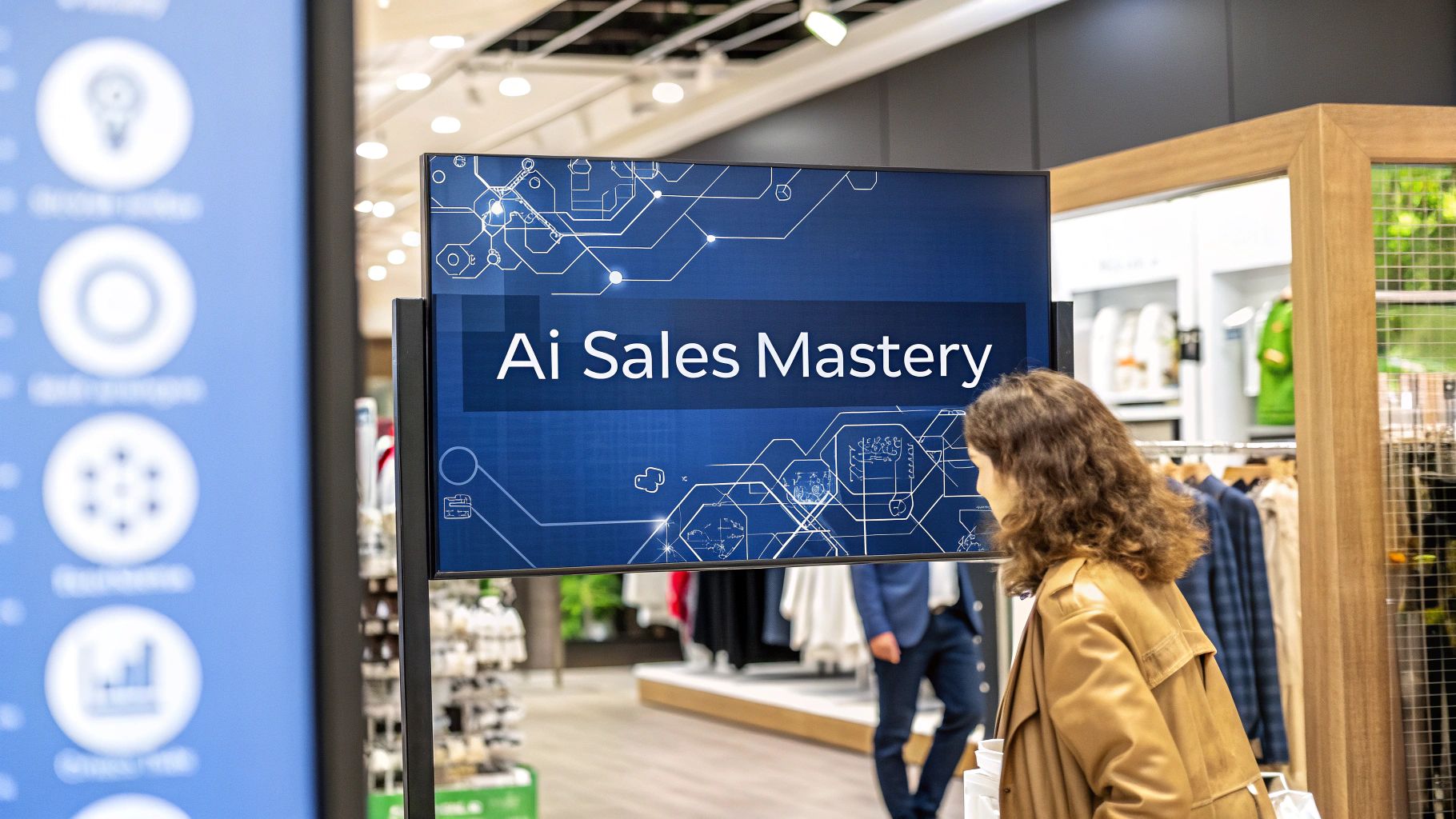Imagine walking into an online store where a personal shopper is waiting just for you, ready to guide you to exactly what you need. That’s the reality of AI in ecommerce; it’s no longer a futuristic idea but the new baseline for staying competitive and delivering the top-tier service that Canadian shoppers have come to expect.
How AI is Reshaping Canadian Ecommerce
In ecommerce, Artificial Intelligence works like a brilliant digital assistant, going far beyond basic automation. A traditional website is like a brick-and-mortar shop with a small staff trying to help everyone at once. An AI-powered site, on the other hand, creates a custom-tailored journey for every single visitor, 24/7. It learns what your customers want on a surprisingly deep level, personalizing their experience and making everything from inventory management to final delivery run smoothly.
This technology sifts through mountains of data, things like browsing habits, purchase history, and even how a user moves their mouse, to predict what a customer is looking for, sometimes before they even realise it themselves. The outcome is a far more intuitive and enjoyable shopping experience that builds real customer loyalty and, of course, boosts sales.
The Core Impact of AI Integration
Bringing AI into your ecommerce platform isn’t just about bolting on a few new features. It’s about rethinking the very foundation of how your business operates and connects with the people who buy from you. The main advantages really boil down to a few key areas:
- Deep Personalization: AI can serve up unique product recommendations, marketing messages, and search results that feel like they were hand-picked for that specific person.
- Operational Efficiency: Behind the scenes, AI is a workhorse. It can predict demand to avoid stockouts, optimize warehouse logistics, and even find the most efficient delivery routes, all of which cut costs and speed things up.
- Enhanced Customer Support: Smart chatbots and virtual assistants can provide instant, accurate answers to common questions, which frees up your human support team to handle the more complex or sensitive issues that need a personal touch.
By applying techniques like machine learning and data mining, retailers can analyze vast amounts of data in real time to identify patterns and make accurate predictions. This capability is central to creating a responsive and customer-centric online store.
Ultimately, adopting AI means moving away from a one-size-fits-all strategy and toward a dynamic, one-to-one relationship with each customer. As we’ll see, this change is vital for any business looking to grow. To get a better sense of the bigger picture, you can find a great discussion on how Artificial Intelligence impacts B2C marketing.
For businesses ready to leap, partnering with experts in AI-powered Ecommerce development services is the logical first step. As we explain on our about us page, Cleffex is dedicated to building the smarter, more successful online stores of the future.
Creating One-to-One Customer Experiences
In ecommerce, the holy grail has always been moving away from generic, one-size-fits-all marketing and towards creating genuinely personal conversations with every shopper. This is precisely where AI makes its biggest impact, sifting through mountains of customer data to craft a unique shopping journey for each individual.

Think of AI algorithms as digital detectives. They meticulously analyze everything from browsing history and past purchases to items left lingering in a shopping cart. All this information is then pieced together to build a living, breathing profile for each shopper, allowing the system to predict their needs and preferences with uncanny accuracy.
This isn’t just about randomly suggesting products. It’s about creating those small, intuitive moments that make a customer feel understood. When you get it right, this kind of deep personalisation doesn’t just build lasting customer loyalty; it directly improves your bottom line.
From Data Points to Delighted Customers
So, how does this actually work? The magic lies in turning all that raw data into a bespoke experience through several clever AI applications. Each one is designed to make the customer feel seen and valued, which is the whole point of weaving smart technology into your platform.
- Predictive Product Recommendations: We’ve all seen the “You might also like…” sections, but modern AI takes this much further. It can pinpoint complementary items, suggest a raincoat because it’s pouring in the customer’s city, or even push new arrivals from their favourite brands to the forefront.
- Hyper-Personalized Marketing: Forget about generic email blasts. AI can trigger messages based on a user’s specific actions. Imagine a gentle follow-up email with a small discount on a pair of shoes a customer viewed three times but never bought. That’s AI at work.
- Dynamic Website Content: An AI-powered site can literally change its appearance for every single visitor. A first-timer might be greeted with a welcome offer and a showcase of best-sellers, while a loyal customer sees new accessories related to their last purchase right on the homepage.
By making every single interaction relevant, AI cuts through the noise. It helps customers overcome choice paralysis and guides them straight to the products they’re most likely to love, directly boosting conversion rates and average order value.
This level of detail isn’t just a nice-to-have anymore; it’s a strategic necessity. The AI market in Canada, especially its role in ecommerce, is expected to reach about US$5.20 billion by the end of 2025. What’s more, a staggering 84% of Canadian ecommerce companies now consider AI a top priority, showing just how critical personalisation has become.
To learn more about putting these powerful ideas into practice, you can explore the ultimate guide to ecommerce personalization.
Optimizing Your Operations with AI
It’s easy to get caught up in how AI creates those magical, personalized experiences for customers. But behind the scenes, AI is an absolute powerhouse for your backend operations. While a great front-end drives sales, a smart back-end is where you slash costs and build a truly resilient business. Think of AI as the conductor of an orchestra, making sure every part of your ecommerce operation is playing in perfect harmony.
Intelligent systems are tackling some of the oldest, most stubborn problems in retail. From keeping the warehouse running smoothly to stopping fraud in its tracks, AI brings a predictive edge and a level of automation that people just can’t replicate at scale. This leads to smarter, data-backed decisions on everything from how much stock you should carry to how quickly you can get a package to a customer’s door.
This image of an AI chatbot shows just one piece of the puzzle, where AI handles customer questions efficiently and frees up your team.

As you can see, conversational AI is a simple but effective way to improve the flow of your customer support, letting your human agents focus on the really tough problems.
Getting a Handle on Core Business Functions
Bringing AI into your operations isn’t about replacing your team; it’s about giving them supercharged tools. These systems can sift through mountains of data to spot patterns and predict what’s coming next, making your entire operation more efficient and, ultimately, more profitable. You’ll see the impact in a few key areas right away.
To break it down, here’s a look at how AI plugs into different parts of your ecommerce machine and the benefits you can expect.
Key AI Applications in Ecommerce Operations
| Operational Area | AI Application | Primary Business Benefit |
|---|---|---|
| Inventory | Predictive Demand Forecasting | Prevents stockouts and overstocking, optimizing cash flow. |
| Supply Chain | Route & Warehouse Optimization | Reduces shipping costs and speeds up delivery times. |
| Pricing | Real-Time Dynamic Pricing | Maximizes revenue by adjusting to market demand automatically. |
| Security | Advanced Fraud Detection | Protects revenue and customer trust by stopping fraud proactively. |
Each of these applications works to remove guesswork and replace it with data-driven precision, giving you a serious competitive edge. Let’s dig a little deeper into what this looks like in practice.
- Predictive Inventory Management: AI doesn’t just look at last year’s sales. It analyzes historical data, current market trends, and even things like upcoming holidays or weather forecasts to predict demand with scary accuracy. This means no more tying up cash in products that won’t sell or disappointing customers when a popular item is out of stock.
- Intelligent Logistics and Supply Chain: Getting products from point A to B efficiently is a massive logistical puzzle. AI figures out the best delivery routes and streamlines how your warehouse works. As we cover in our guide to AI in supply chain and logistics, this cuts down on shipping costs and gets orders delivered faster, a huge factor in keeping customers happy.
- Dynamic Pricing Strategies: AI can keep an eye on what your competitors are charging, how much demand there is for a product, and your current stock levels, all in real-time. This allows it to automatically tweak prices to stay competitive and maximize your profit margins, without you having to lift a finger.
Securing Your Store and Building Trust
One area of operations that’s often overlooked but absolutely critical is security. Especially for Canadian businesses, earning and keeping customer trust is everything. AI is a game-changer here, particularly when it comes to fraud detection.
AI-powered fraud systems can scan thousands of transactions a second, picking out suspicious patterns that would be completely invisible to a human. It’s a proactive defense that protects your business and your customers from financial headaches.
A perfect example of this is machine learning fraud detection. These systems actually learn from every single transaction, getting smarter and better at spotting fraud over time while also reducing the number of legit orders that get accidentally flagged. It’s a clear-cut way to build a more secure and efficient foundation for your ecommerce growth.
The Power of AI-Driven Conversations
Let’s be honest, customer expectations for online support have changed dramatically. We’ve all been frustrated by clunky, scripted chatbots that can barely handle basic questions. Those days are quickly becoming a thing of the past. The real conversation now is about intelligent virtual assistants that provide genuinely helpful support 24/7, setting a whole new standard for how we interact with brands.
These aren’t your old-school bots. Modern AI assistants can do so much more than just tell you, “Where is my order?” They can actually understand complex questions, offer surprisingly good product recommendations based on what a shopper is looking for, and even close a sale right there in the chat window. This evolution is a central piece of the puzzle for any modern AI in an Ecommerce strategy.
When you have that kind of immediate, always-on support, it does more than just make customers happy. It frees up your human team to tackle the bigger, more creative challenges that an AI can’t handle, instead of getting bogged down in repetitive queries.
Evolving from Chatbots to True Assistants
The real breakthrough here is the quality of the conversation itself. Today’s AI assistants use something called natural language processing (NLP) to grasp not just the words a customer types, but what they actually mean. This is what makes the interaction feel so much more fluid and, well, human.
- Real Problem-Solving: A customer can describe a need in their own words, like, “I need a gift for a friend who loves hiking,” and the AI can actually guide them to the perfect product.
- Proactive Engagement: The best assistants don’t just wait to be asked. They can sense when a shopper might be stuck on a page and pop up with a helpful tip or a timely discount, which is a great way to lower cart abandonment.
- Voice Search Integration: As more of us use voice commands to shop, AI is making those hands-free interactions feel completely seamless.
The goal is to create the kind of immediate, interactive, and genuinely helpful service experiences that set leading brands apart from the competition. It’s about being there for the customer, exactly when they need you.
This shift is a massive driver of growth. Here in Canada, the ecommerce scene is heavily influenced by these AI-powered platforms. As the global conversational commerce market rockets toward $8.8 billion, we’re seeing that trend reflected in Canadian online retail. There’s a clear demand for instant, intelligent support. You can discover more insights about the Canadian ecommerce market on aftership.com.
For businesses ready to put these powerful tools to work, partnering with specialized Ecommerce Development Services is key. As we explored in our AI in Ecommerce adoption guide, a well-thought-out strategy is the difference between a frustrating gimmick and a system that delivers real value from day one.
Your Roadmap to Implementing AI
So, you’re ready to bring AI into your ecommerce business? The idea might feel a little overwhelming, but a successful rollout doesn’t mean you have to tear down your entire operation and start from scratch. It’s all about having a clear, practical plan that zeroes in on specific problems and delivers results you can actually see.
The best place to start is by looking at your biggest headaches. Are you bleeding sales from abandoned carts? Struggling to keep customers engaged? Or is your warehouse a chaotic mess of overstocked and out-of-stock items? Nailing down these pain points is the first step. It lets you pick AI tools designed to solve those exact problems, ensuring you get a real return on your investment.
Choosing Your Integration Path
Once you know what you want to fix, you can figure out how to fix it. For a lot of Canadian businesses, the easiest entry point is using off-the-shelf solutions that plug right into platforms like Shopify. These tools can give you powerful features, think AI-powered product recommendations or automated customer service chatbots, without needing a huge team of developers.
On the other hand, if your business has very specific needs or you want to build a truly unique advantage, a custom-built solution might be the way to go. This approach gives you complete control and can be moulded perfectly to fit how you already work.
The key is to start small, measure the impact, and scale your efforts wisely. A successful first project, like launching an AI chatbot that cuts down on support tickets, creates momentum. It also gives you priceless data for your next, more ambitious AI project.
This step-by-step approach is catching on fast. Here in Canada, AI adoption in ecommerce is really taking off. A recent study found that about 71% of small and medium-sized enterprises (SMEs) are already using AI for things like customer service and inventory management. Better yet, nearly three-quarters of them plan to invest even more. If you’re curious, you can read the full research about AI adoption in Canadian SMEs.
Partnering for a Smooth Transition
Let’s be honest: navigating the world of AI can be tricky. Working with specialists in AI-powered ecommerce development is a smart move. An experienced partner can help you sidestep common mistakes, pick the right tools for the job, and make sure they’re set up to deliver the best possible results. They help build a solid foundation for your future growth.
A strategic partnership is often the single biggest difference between a project that fizzles out and one that truly succeeds. At Cleffex, we focus on building solutions that deliver real-world value. Our team is dedicated to helping businesses just like yours thrive in this new era of commerce.
Navigating the Future of AI in Retail
Jumping into artificial intelligence offers a huge upside for retailers, but it’s not without its own set of challenges. The growth potential is undeniable, yet getting there means carefully navigating real-world hurdles like data privacy, the initial investment costs, and the risk of algorithmic bias. It’s less like flipping a switch and more like building a new, smarter foundation for your business, one that’s both powerful and responsible.

A successful strategy for AI in Ecommerce puts ethical data handling and customer transparency front and centre. Shoppers are more aware than ever about how their personal information is being used, so building and maintaining their trust is absolutely essential. This means being upfront about your data practices and working to ensure your AI systems are designed to be fair and unbiased.
Emerging Trends Shaping Tomorrow’s Stores
Looking down the road, a few exciting trends are starting to pop up that will completely change what online shopping feels like. They’re blending technology with a human touch in some really powerful ways.
- Generative AI for Content: Think about what it would take to write thousands of unique, engaging product descriptions or marketing emails. Now imagine doing it in minutes. That’s the power of generative AI. It frees up your creative teams to focus on big-picture strategy instead of getting bogged down in repetitive writing.
- Hyper-Personalization at Scale: We’re already moving past basic product recommendations. The next step involves AI agents that act like personal digital shoppers for your customers, anticipating what they need and tailoring every single interaction in real-time.
- Augmented Reality (AR) Try-Ons: AR is closing the gap between browsing online and shopping in-store. This tech lets customers “try on” a new outfit from their living room or see exactly how a new sofa would look by their window. It’s an immersive experience that builds buyer confidence and helps cut down on returns.
The real magic happens when you get this seamless fusion of advanced tech and human insight right. That’s how you create a shopping experience that isn’t just efficient and personal, but genuinely enjoyable and trustworthy for your customers.
Making your way through this evolving field takes real expertise. As we explored in our AI in Ecommerce adoption guide, having the right partner can make all the difference. The team at Cleffex is focused on helping businesses like yours put these forward-thinking solutions into practice.
Answering Your Questions About AI in Ecommerce
As business owners start looking into artificial intelligence, a lot of practical questions naturally come up. Let’s walk through some of the most common ones to help you get a clearer picture and decide on the best path forward for your AI in ecommerce strategy.
What Does It Cost to Add AI to an Online Store?
The honest answer? It really depends. The investment for integrating AI can range from an affordable monthly fee for a simple plug-and-play tool to a much larger budget for a custom-built system designed specifically for your store’s unique challenges.
But the initial cost is only half the equation. A smart AI implementation isn’t just an expense; it’s an investment that should pay for itself. By boosting sales, increasing the average order value, and cutting down on operational costs, the right AI solution delivers a strong return, making it a wise financial move for any business.
Will AI Replace Jobs in the Ecommerce Industry?
It’s easy to see why this is a common concern, but the reality is much more collaborative. It’s far more likely that AI will work alongside your team, enhancing their roles rather than eliminating them. AI is fantastic at handling the repetitive, data-heavy tasks that slow people down. This frees up your team to focus on what humans do best: strategy, creativity, and connection.
Think of it as giving your team superpowers. Instead of getting bogged down in manual data entry or answering the same customer questions over and over, they can dedicate their time to building genuine customer relationships, crafting innovative marketing campaigns, and pushing the business forward.
What Is the Best First Step for a Small Business?
If you’re a small business, the key is to start small and focused. Don’t try to boil the ocean. Instead, pick one specific, nagging problem you’re facing. Is it a stubbornly high cart abandonment rate? Are you drowning in customer service tickets? Or is your inventory management a constant headache?
Once you’ve identified your biggest pain point, you can look for AI tools designed to solve that exact issue. As we explored in our AI in Ecommerce adoption guide, nailing a single, targeted project first builds incredible momentum and provides a solid foundation to build on later. Getting help from experts in Ecommerce Development Services can also ensure you start on the right foot.
At Cleffex, our AI-powered ecommerce Development Services are all about helping you find your way in this new territory. To learn more about our team and how we approach innovation, feel free to visit our about us page.








